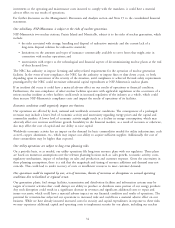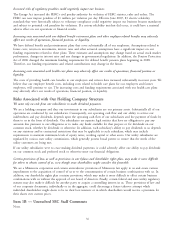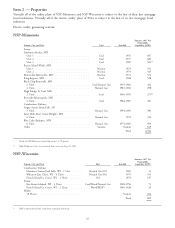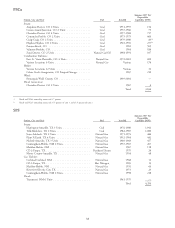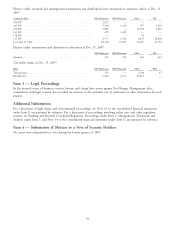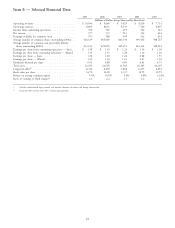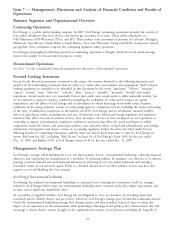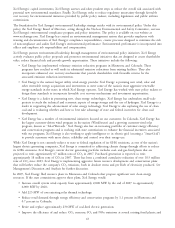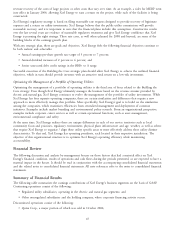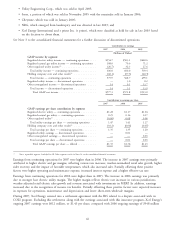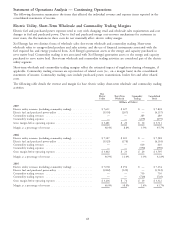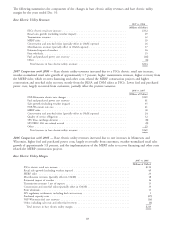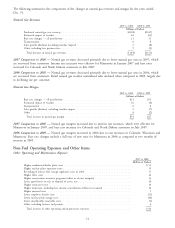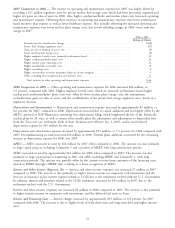Xcel Energy 2007 Annual Report Download - page 53
Download and view the complete annual report
Please find page 53 of the 2007 Xcel Energy annual report below. You can navigate through the pages in the report by either clicking on the pages listed below, or by using the keyword search tool below to find specific information within the annual report.Xcel Energy’s capital investments, Xcel Energy assesses and takes prudent steps to reduce the overall risk associated with
potential new environmental mandates. Finally, Xcel Energy seeks to reduce regulatory uncertainty through favorable
cost recovery for environmental initiatives provided by public policy makers, including legislatures and public utilities
commissions.
The foundation for Xcel Energy’s environmental leadership strategy resides with its environmental policy. Under this
policy, the Xcel Energy Board of Directors, acting through the Nuclear, Environmental and Safety Committee, oversees
Xcel Energy’s environmental compliance program and policy initiatives. The policy is available on our website at
www.xcelenergy.com. Xcel Energy has created an environmental management system that provides employees with
training and documentation of Xcel Energy’s compliance responsibilities, creates processes designed to minimize the risk
of noncompliance and audits Xcel Energy’s environmental performance. Environmental performance is incorporated into
officer and employee job responsibilities and compensation.
Xcel Energy pursues environmental leadership through management of environmental policy initiatives. Xcel Energy
actively evaluates public policy proposals and promotes environmental initiatives that are designed to create shareholder
value, reduce financial risk and provide growth opportunities. These initiatives include the following:
• Xcel Energy has implemented voluntary emission reduction programs in Minnesota and Colorado. These
programs have resulted or will result in substantial emission reductions from existing facilities. They also
incorporate enhanced cost recovery mechanisms that provide shareholders with favorable returns for the
associated emission reduction investments.
• Xcel Energy is the nation’s largest utility wind energy provider. Xcel Energy is pursuing new wind, solar and
other renewable energy acquisitions and investments to meet some of the nation’s most aggressive renewable
energy standards in the states in which Xcel Energy operates. Xcel Energy has worked with state policy makers to
design these standards to incorporate favorable cost recovery mechanisms and investment opportunities.
• Xcel Energy is a leader in promoting new, clean energy technologies. Xcel Energy has undertaken small-scale
projects to study the technical and economic aspects of energy storage and the use of hydrogen. Xcel Energy is a
leader in supporting the advancement of solar energy technology. Xcel Energy is also exploring the use of clean
coal and is evaluating whether and how to best take advantage of state and federal incentives for clean coal
development.
• Xcel Energy has a number of environmental initiatives focused on our customers. In Colorado, Xcel Energy has
the largest customer-driven wind program in the nation (WindSource) and a growing customer-sited solar
program, known as ‘‘Solar*Rewards.’’ Xcel Energy also has an increasing portfolio of customer energy efficiency
and conservation programs and is working with state commissions to enhance the financial incentives associated
with our programs. Xcel Energy is also working to apply intelligence to its electric grid (creating a ‘‘SmartGrid’’)
to provide customers with more choice, reliability and control over their energy use.
While Xcel Energy is not currently subject to state or federal regulation of its GHG emissions, as one of the nation’s
largest electric generating companies, Xcel Energy is committed to addressing climate change through efforts to reduce
its GHG emissions. Xcel Energy’s current electric generating portfolio includes coal- and gas-fired plants that are
projected to emit approximately 67 million tons of CO2 in 2007. Purchased generation is expected to emit
approximately 18 million tons of CO2 in 2007. There has been a combined cumulative reduction of over 18.5 million
tons of CO2 since 2003. Xcel Energy is implementing aggressive future resource development and conservation plans
that will further reduce the company’s CO2 emissions, both in absolute terms and per Kwh of electricity produced. See
Management’s Discussion and Analysis for further discussion.
In 2007, Xcel Energy filed resource plans in Minnesota and Colorado that propose significant new clean energy
resources. If the state commissions approve these plans, Xcel Energy would:
• Increase overall system wind capacity from approximately 2,800 MW by the end of 2007 to approximately
6,000 MW by 2020;
• Add 225 MW of concentrating solar thermal technology;
• Reduce retail demand through energy efficiency and conservation programs by 1.1 percent in Minnesota and
0.7 percent in Colorado;
• Retire and replace approximately 230 MW of coal-fired electric generation;
• Improve the efficiency of and reduce CO2, mercury, SO2 and NOx emissions at several existing fossil plants; and
43



